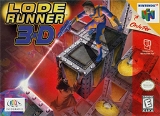
Lode Runner 3-D
Encyclopedia
Lode Runner 3-D is a Nintendo 64
game based on the Lode Runner
franchise. The game was developed by Big Bang and was released in 1999 in Japan by Banpresto
and North America by Infogrames
.
The game is an excellent example of the trap-em-up genre, which also includes games like Heiankyo Alien
and Space Panic
.
Nintendo 64
The , often referred to as N64, was Nintendo′s third home video game console for the international market. Named for its 64-bit CPU, it was released in June 1996 in Japan, September 1996 in North America, March 1997 in Europe and Australia, September 1997 in France and December 1997 in Brazil...
game based on the Lode Runner
Lode Runner
Lode Runner is a 1983 platform game, first published by Brøderbund. It is one of the first games to include a level editor, a feature that allows players to create their own levels for the game. This feature bolstered the game's popularity, as magazines such as Computer Gaming World held contests...
franchise. The game was developed by Big Bang and was released in 1999 in Japan by Banpresto
Banpresto
is a Japanese toy company, best known in America for game development, headquartered in the Shinagawa Seaside West Building in Shinagawa, Tokyo. It was founded April 1977 as Hoei Sangyo, Co. Ltd. The company was renamed Coreland in 1982, and during the 1980s it worked mainly as a subcontractor for...
and North America by Infogrames
Infogrames
Infogrames Entertainment SA was an international French holding company headquartered in Paris, France. It was the owner of Atari, Inc., headquartered in New York City, U.S. and Atari Europe. It was founded in 1983 by Bruno Bonnell and Christophe Sapet using the proceeds from an introductory...
.
Gameplay
The game mechanics are similar to the original; you outrun 'monsters' by using alternate routes, sliding on ropes, climbing ladders, or drilling holes in the ground to trap them. This game differs from the other incarnations of games from the series because of its apparent three-dimensional perspective. While essentially running in 2-dimensional space, the player has an option to move in another direction every so often. The levels are mostly spirals that require climbing to complete. There are five worlds, and each one must be unlocked by finding five cards from the previous world, excluding the first. Each world is divided into five stages, with each stage divided into four levels. The general goal of each level is to collect a certain amount of gold to activate a portal that allows the player to continue. As the player progresses, each world adds new interactive objects and tools, as well as new obstacles.The game is an excellent example of the trap-em-up genre, which also includes games like Heiankyo Alien
Heiankyo Alien
is a video game created by the University of Tokyo's Theoretical Science Group in 1979. The game was originally developed and released as a personal computer game in 1979, and was then published by Denki Onkyō Corporation as an arcade game in January 1980...
and Space Panic
Space Panic
Space Panic is a 1980 arcade game designed by Universal, which Chris Crawford calls the first ever platform game, as it pre-dates Nintendo's Donkey Kong which is often cited as the original platform game. Space Panic lacks Donkey Kongs jump mechanic, disqualifying it as a platformer for some...
.

